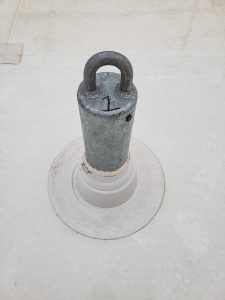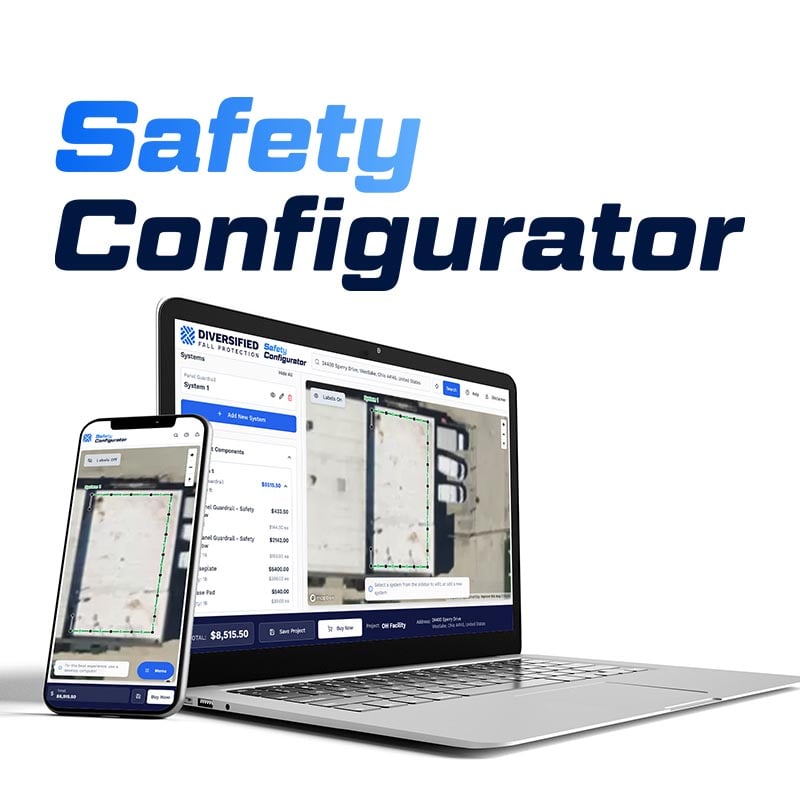Are Window Washing Contractors Responsible for Anchorage of their Equipment and Safety Lines?
 Prior to recent updates to the Walking Working Surfaces regulations, OSHA had little to say regarding rope descent system (RDS) commonly utilized by window washing contractors. The absence of specific regulations pertaining to RDS often put building owners and contractors at odds over which party was responsible for window washing anchor inspection and certification. In some instances, building owners would include contractual provisions requiring window washing contractors to supply their own means of anchorage and fall protection. The absence of clearly worded regulations created unsafe working conditions since delineation of responsibilities between the building owner and window washing contractor was not well defined.
Prior to recent updates to the Walking Working Surfaces regulations, OSHA had little to say regarding rope descent system (RDS) commonly utilized by window washing contractors. The absence of specific regulations pertaining to RDS often put building owners and contractors at odds over which party was responsible for window washing anchor inspection and certification. In some instances, building owners would include contractual provisions requiring window washing contractors to supply their own means of anchorage and fall protection. The absence of clearly worded regulations created unsafe working conditions since delineation of responsibilities between the building owner and window washing contractor was not well defined.
Joint Responsibility for OSHA Compliance
OSHA 1910.27 provides clarification regarding rope descent systems (RDS). Building owners and window washing contractors each have responsibilities and associated liability. According to OSHA 1910.27(b)(1)(i) the building owner must provide written documentation to the contractor “that the building owner has identified, tested, certified, and maintained each anchorage so it is capable of supporting at least 5,000 pounds, in any direction, for each employee attached”. The information provided is to be based on an annual inspection by a qualified person and certification of each anchorage by a qualified person. Documentation of the latest annual inspection must be within one year from the current date of service and documentation of the latest certification must be within ten years from the current date of service.
OSHA defines a qualified person as “a person who, by possession of a recognized degree, certificate, or professional standing, or who by extensive knowledge, training, and experience has successfully demonstrated the ability to solve or resolve problems relating to the subject matter, the work, or the project”.
Although the building owner is responsible for providing certified anchorages to the window washing contractor, per OSHA 1910.27(b)(1)(ii), the window washing contractor carries responsibility to ensure that “no employee uses any anchorage before the employer has obtained written information from the building owner that the requirements of paragraph (b)(1)(i) of this section”.
Put another way, the new OSHA regulations make both the building owner and the window washing contractor jointly responsible for ensuring employee safety when rope descent systems are in use.
Summary of OSHA Rope Descent System Regulations
Here is the complete text of all the OSHA regulations pertaining to anchorages used in conjunction with rope descent systems:
1910.27(b)
Rope descent systems–
1910.27(b)(1)
Anchorages.–
1910.27(b)(1)(i)
Before any rope descent system is used, the building owner must inform the employer, in writing that the building owner has identified, tested, certified, and maintained each anchorage so it is capable of supporting at least 5,000 pounds (2,268 kg), in any direction, for each employee attached. The information must be based on an annual inspection by a qualified person and certification of each anchorage by a qualified person, as necessary, and at least every 10 years.
1910.27(b)(1)(ii)
The employer must ensure that no employee uses any anchorage before the employer has obtained written information from the building owner that each anchorage meets the requirements of paragraph (b)(1)(i) of this section. The employer must keep the information for the duration of the job.
1910.27(b)(1)(iii)
The requirements in paragraphs (b)(1)(i) and (ii) of this section must be implemented no later than November 20, 2017.
1910.27(b)(2)
Use of rope descent systems. The employer must ensure:
1910.27(b)(2)(i)
No rope descent system is used for heights greater than 300 feet (91 m) above grade unless the employer demonstrates that it is not feasible to access such heights by any other means or that those means pose a greater hazard than using a rope descent system;
1910.27(b)(2)(ii)
The rope descent system is used in accordance with instructions, warnings, and design limitations set by the manufacturer or under the direction of a qualified person;
1910.27(b)(2)(iii)
Each employee who uses the rope descent system is trained in accordance with § 1910.30;
1910.27(b)(2)(iv)
The rope descent system is inspected at the start of each workshift that it is to be used. The employer must ensure damaged or defective equipment is removed from service immediately and replaced;
1910.27(b)(2)(v)
The rope descent system has proper rigging, including anchorages and tiebacks, with particular emphasis on providing tiebacks when counterweights, cornice hooks, or similar non-permanent anchorages are used;
1910.27(b)(2)(vi)
Each employee uses a separate, independent personal fall arrest system that meets the requirements of subpart I of this part;
1910.27(b)(2)(vii)
All components of each rope descent system, except seat boards, are capable of sustaining a minimum rated load of 5,000 pounds (22.2 kN). Seat boards must be capable of supporting a live load of 300 pounds (136 kg);
1910.27(b)(2)(viii)
Prompt rescue of each employee is provided in the event of a fall;
1910.27(b)(2)(ix)
The ropes of each rope descent system are effectively padded or otherwise protected, where they can contact edges of the building, anchorage, obstructions, or other surfaces, to prevent them from being cut or weakened;
1910.27(b)(2)(x)
Stabilization is provided at the specific work location when descents are greater than 130 feet (39.6 m);
1910.27(b)(2)(xi)
No employee uses a rope descent system when hazardous weather conditions, such as storms or gusty or excessive wind, are present;
1910.27(b)(2)(xii)
Equipment, such as tools, squeegees, or buckets, is secured by a tool lanyard or similar method to prevent it from falling; and
1910.27(b)(2)(xiii)
The ropes of each rope descent system are protected from exposure to open flames, hot work, corrosive chemicals, and other destructive conditions.
Next Steps
A successful and compliant fall protection program is one that is properly designed, documented, and maintained under the direction of a qualified person. The qualified engineering team at Diversified Fall Protection can assist with the certification of your existing suspended access anchorage system, or the design and implementation of a new compliant anchorage system. To learn more about design, inspections, and certification of window washing anchors used for rope descent applications, contact the safety specialists at Diversified Fall Protection for further assistance.
Schedule an assessment with Diversified Fall Protection
Contact Us to request a fall safety review

b-1.jpg?width=1368&height=1340&name=Rail%20(175)b-1.jpg)

